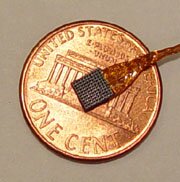Thu 14 Oct 2004

The tiny sensor consists of an array of 100 electrodes to capture signals from the brain. (© Alamy)
Roxanne Khamsi, Nature.com News, reports:
An pill-sized brain chip has allowed a quadriplegic man to check e-mail and play computer games using his thoughts. The device can tap into a hundred neurons at a time, and is the most sophisticated such implant tested in humans so far.
Many paralysed people control computers with their eyes or tongue. But muscle function limits these techniques, and they require a lot of training. For over a decade researchers have been trying to find a way to tap directly into thoughts.
In June 2004, surgeons implanted a device containing 100 electrodes into the motor cortex of a 24-year-old quadriplegic. The device, called the BrainGate, was developed by the company Cyberkinetics, based in Foxborough, Massachusetts. Each electrode taps into a neuron in the patient’s brain.
The BrainGate allowed the patient to control a computer or television using his mind, even when doing other things at the same time. Researchers report for example that he could control his television while talking and moving his head.
The team now plans to implant devices into four more patients.
Rival teams are building devices to read brain activity without touching neurons. Neural Signals, based in Atlanta, has patented a conductive skull screw that sits outside the brain, just under the skull. Other researchers are developing non-invasive technologies, for example using an electroencephalogram to read a patient’s thoughts.
But BrainGate’s creators argue that such techniques only give a general picture of brain activity, and that the more direct approach allows more numerous and more specific signals to be translated. “This array has 100 electrodes, so one can theoretically tap into 100 neurons,” says Jon Mukand, an investigator on the team based at the Sargent Rehabilitation Center in Rhode Island.
This makes the technology faster and more flexible, he argues. “It’s far more versatile when one can get a larger number of neurons.”
But Stephen Roberts, an engineer at Oxford University, UK, who has worked on brain-computer interfaces, says the field is still waiting for a breakthrough. “We have to make something that works robustly and without a lot of patient training,” he says. “Most of these devices work well on a small subset of patients, but there’s a long way to go before getting them to work for the general population.”
Published online: 13 October 2004; | doi:10.1038/news041011-9